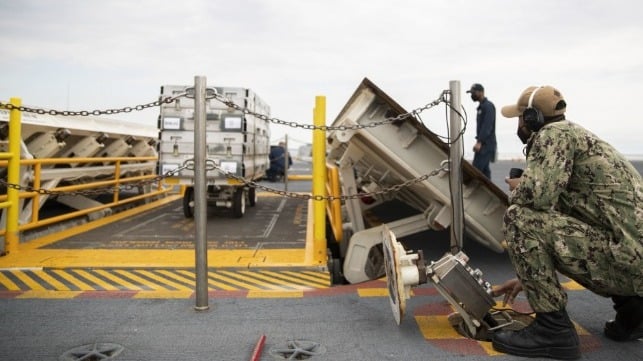USS Ford Exits Post-Delivery "Test and Trials" Shakedown

After a year and a half, the aircraft carrier USS Gerald R. Ford has formally closed out a unique "post-delivery test and trials" period. Though four of her 11 weapons elevators are not yet operating and she is not equipped to support the Navy's most modern fighter jet, the service says that Ford's crew have made great strides in preparing the vessel for operations. They have corrected almost all of the 9,000 work items that were incomplete when the Navy accepted delivery of the $13 billion vessel, and they are making enough progress that they may shorten the estimated six-year delay in the timeline for Ford's first deployment.
The carrier's troubled electromagnetic aircraft launch system (EMALS) and advanced arresting gear (AAG) have now completed over 8,000 catapult and trap cycles, including about 7,300 during the past 18-month cycle of sailings and pierside repairs. This is approximately equal to the number of launches and recoveries that would be conducted in a typical six-month carrier deployment, according to the Navy.
In addition, the crew has cycled the vessel's unique electromagnetic weapons elevators about 14,000 times, including about 7,000 times at sea. Unlike the elevator systems aboard previous generations of American carriers, Ford's elevators are electromagnetically powered, and the technology behind them was not developed to maturity before installation. The elevators are essential for resupplying Ford's air wing with munitions, and none were fully functional when the ship was delivered in 2017. The Navy brought in outside expert advisors to come up with solutions, and over the past four years, its contractors have carried out extensive rework to bring seven out of 11 units up to functioning status.
“[Ford's] sailors are mastering the intricacies of each unique elevator,” said Rear Adm. James Downey, the program executive officer for aircraft carriers. “They’re testing design tolerances and doing a great job fine-tuning operation and maintenance best practices toward the goal of achieving full combat system certification aboard the ship.”
Ford also completed her Combat Systems Ship’s Qualification Trials - a test of her organic point-defense combat systems - with an "exceptional performance," according to the Navy. The crew destroyed surface and airborne drone targets as required using the vessel's Phalanx gun and onboard missiles systems.
“Completing Gerald R. Ford’s Combat Systems Qualification is a significant milestone,” said Capt. Brian A. Metcalf, the program manager for the Ford-class. “It takes weeks of planning, combat scenario development, target coordination, onboard training, and live ammunition load-outs to ready the ship for operational testing that reflects a real-time, at-sea threat environment."
Next up for Ford is a series of shock trials - the blast tests that the Navy uses to assess the vessel's survivability in the event of a near-miss. A series of progressively larger and closer underwater explosions will test the ship's systems and their ability to withstand damage from shock. It will be the first time that the service has conducted shock trials on a carrier since 1987, when USS Theodore Roosevelt underwent the severe testing process. The Navy predicts that some of the ship's systems will require repairs during and after the trials, but it does not expect "impacts that would jeopardize the safety of the crew or impact future operations."
